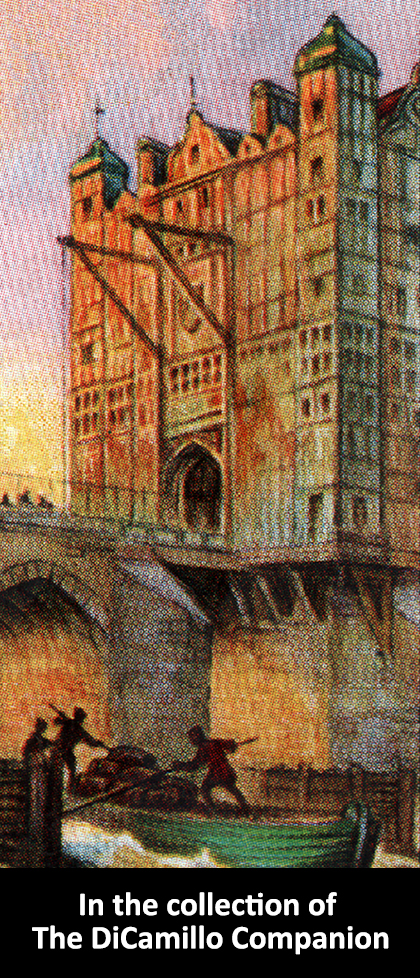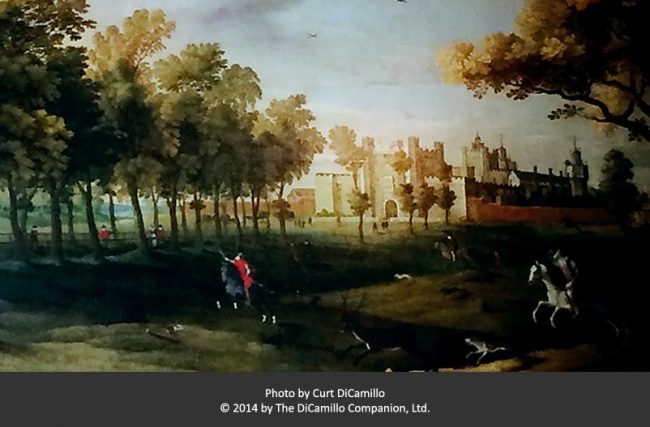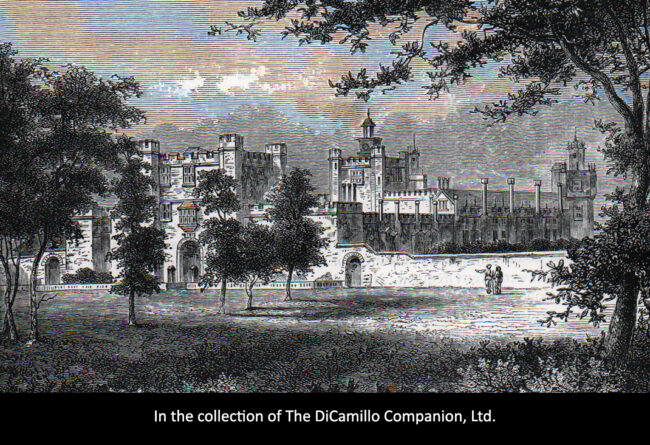
Nonsuch Palace at Old London Bridge in 1577 from a circa 1910 Churchman's Cigarettes card.

Detail of the Palace from an early 17th century Flemish painting, today in the collection of the Fitzwilliam Museum, Cambridge.

The palace from from the 1888 publication "Greater London: A Narrative of its History, its People, and its Places"
Built / Designed For: Henry VIII
House & Family History: During the last years of his life, Nonsuch was Henry VIII's favorite building project. The king's memories of the building erected in 1520 at Guisnes, France, for the Field of the Cloth of Gold prompted him to try to recreate that magical place more permanently at Nonsuch. The palace was designed to be a celebration of the power and grandeur of the Tudor dynasty—physical evidence that England was a major player in European politics. It was also most certainly built to rival Francis I's Château de Chambord. Henry could never forget his beating at the hands of the French king at a wrestling match held at the Field of the Cloth of Gold; Nonsuch would rise as his rival palace, one that he hoped would outshine Chambord. Work began in 1538, but was not complete when Henry died in 1547, though most of the palace was habitable. Nonsuch was approximately 355 feet by 170 feet and contained two courtyards, with stone for the palace brought from Merton Priory. The Palace of Nonsuch cost at least £24,356 by the end of 1545 (approximately £138 million in 2012 values using the labour value commodity index) and is important in architectural history as one of the first buildings in England to show the influence of Italian Renaissance architecture. In 1556 the palace was finished by the 12th Earl of Arundel; the earl's son-in-law, Lord Lumley, sold Nonsuch to Queen Elizabeth I in 1592. The palace was one of the favorite residences Elizabeth, but, after her death, it declined in favor as a royal residence; Nonsuch was demolished between 1682 and 1688. Some of the painted paneling and other fixtures were taken to nearby Loseley Park during the demolition. Virtually nothing remains today of the palace, though excavations in 1959-60 recovered the complete plan and many details of the decoration. During the excavations carved fragments were found in the foundations, including a large 14th century boss, today in the Museum of London. The site of the palace lies in today's Nonsuch Park; its remains are near Cherry Orchard Farm.
Collections: The hall at Loseley Park contains a marble table on alabaster supports with the Tudor rose and the Scottish thistle that was made for Henry VIII for use at Nonsuch Palace. The paneling in the great hall at Loseley also came from Nonsuch. Housed in Lumley Castle and Nonsuch Palace, the Lumley Collection was the largest art collection in Elizabethan England (it included almost 300 paintings, including portraits of 196 contemporary sitters). Created by John Lumley, 1st Baron Lumley (of the third creation), through purchase and commission, the core of the collection was inherited by Lord Lumley from his father-in-law, the 12th Earl of Arundel (from whom he also inherited Nonsuch Palace) and included pictures from the collection of Elizabeth I’s favorite, Robert Dudley, 1st Earl of Leicester. Lord Lumley was unusually cultured for his time. Before such a thing as the Grand Tour existed, he traveled in Italy and spent significant time in Florence in the 1560s. Lord Lumley was also the uncle of Thomas Howard, 14th Earl of Arundel (“the Collector Earl”), possibly 17th century England’s most important collector. Lord Arundel inherited some of Lumley’s collection of paintings; however, a significant portion of the collection remained at Lumley Castle, where it was eventually inherited by the earls of Scarbrough and sold in sales in 1785 and 1807. All of this was documented in “The Lumley Inventory,” also called “The Lumley Inventory and Pedigree” and “The Red Velvet Book” (from its binding), called by Sir Roy Strong “…the most important single document for the history of painting, sculpture, and furniture in the Elizabethan age.” Compiled for Lord Lumley circa 1586-95 by his steward, John Lampton, the illustrated manuscript documents Lumley’s enormous collection of paintings, sculpture, silver, furniture, and books, and also includes a heraldic and genealogical history of the Lumley family that traces their ancestry back through Charlemagne to Adam. The inventory also includes illustrations of garden fountains and outdoor sculpture at Nonsuch Palace, including the Pelican Fountain, today at Sandbeck Park. Now owned by the earls of Scarbrough, the inventory is on long term loan to the Victoria & Albert Museum. In 2010 the Roxburghe Club privately printed a reproduction of “The Red Velvet Book,” 250 copies of which were made available for sale from the London rare book and manuscript dealer Maggs Bros.
Garden & Outbuildings: Grade II-listed elements of the palace's 16th century Banqueting House survive. According to Pevsner's "The Buildings of England: Surrey," the name of the 911-acre Worcester Park comes from one of the two parks of Nonsuch Palace.
Title: Treasure Houses of Britain, The - SOFTBACK
Author: Jackson-Stops, Gervase (Editor)
Year Published: 1985
Reference: pg. 412
Publisher: Washington, DC: National Gallery of Art (New Haven: Yale University Press)
ISBN: 0300035530
Book Type: Softback
Title: Buildings of England: Surrey, The
Author: Nairn, Ian; Pevsner; Nikolaus; Cherry, Bridget (Reviser)
Year Published: 1971
Reference: pgs. 383-387, 539
Publisher: London: Penguin Books
ISBN: 140710213
Book Type: Hardback
Title: Treasure Houses of Britain, The - SOFTBACK
Author: Jackson-Stops, Gervase (Editor)
Year Published: 1985
Reference: pg. 409
Publisher: Washington, DC: National Gallery of Art (New Haven: Yale University Press)
ISBN: 0300035530
Book Type: Softback
House Listed: Demolished
Park Listed: Not Listed
Past Seat / Home of: King Henry VIII, 1542-47. Queen Mary I, until 1556. Henry Fitzalan, 12th (or 17th) Earl of Arundel, 1556-80. John Lumley, 1st Baron Lumley (third creation), 1580-92. Queen Elizabeth I, 1592-1603. Queen Anne of Denmark, 1610s. Major-General John Lambert, 1650s. General Thomas Pride, until 1658. Queen Henrietta Maria, 1660-69. Barbara, Countess of Castlemaine, 1670-82.
Current Ownership Type: Demolished
Primary Current Ownership Use: Demolished
House Open to Public: No
Historic Houses Member: No